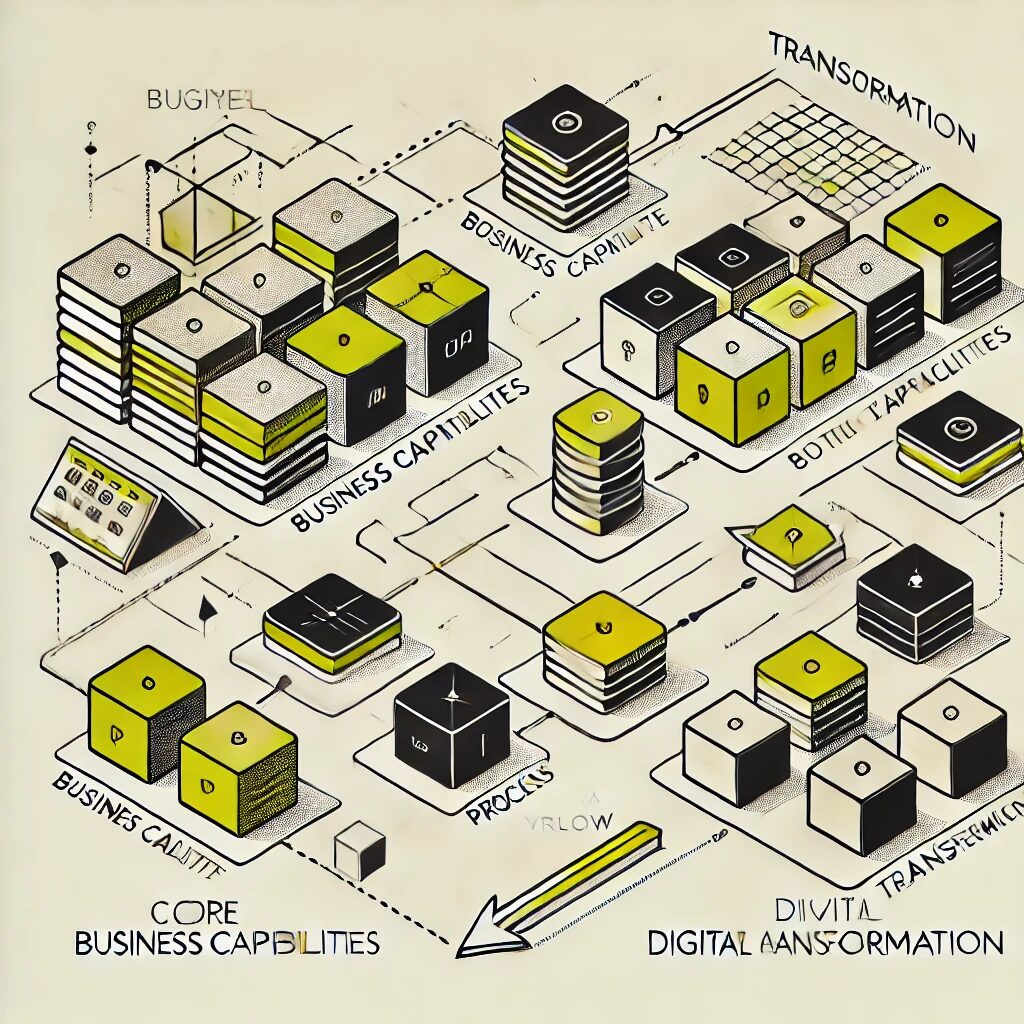
Enterprise Architecting the Future of Investment Banking. Beyond Technology: How Enterprise Architecture Powers Investment Banking’s Digital Renaissance
Today’s investment banks face unprecedented disruption—from fintech competitors and digital-native challengers to changing client expectations and regulatory pressures. The traditional approaches that once defined success in investment banking are being fundamentally reinvented through digital capabilities, data-driven insights, and platform business models.
Enterprise Architecture (EA) has emerged as the critical discipline that connects business vision to digital execution. By creating a coherent blueprint that spans strategy, capabilities, processes, information, and technology, EA provides investment banks with the foundation to navigate complex transformation journeys confidently and precisely. It transforms digital initiatives from disconnected technology projects into strategic business transformations that deliver sustainable competitive advantage in an increasingly dynamic market.
1: The Digital Imperative for Investment Banking
Investment banks stand at a digital crossroads where technology is no longer merely an enabler of traditional business—it’s fundamentally reshaping value propositions, client engagement models, and competitive boundaries in capital markets and advisory services.
- Competitive Disruption: Fintech challengers and digitally-native market entrants are unbundling traditional investment banking value chains, targeting high-margin services with specialized digital platforms that operate at a fraction of legacy cost structures.
- Client Experience Evolution: Corporate and institutional clients increasingly expect the same digital fluency they experience as consumers—demanding personalized insights, seamless omnichannel engagement, and real-time transparency throughout complex transactions.
- Margin Pressure Reality: The combination of fee compression, regulatory capital requirements, and operational complexity has created relentless pressure on investment banking margins that can only be addressed through digital-enabled efficiency and new revenue models.
- Regulatory Complexity: The expanding scope and granularity of regulatory requirements demand sophisticated data management and reporting capabilities that cannot be sustainably addressed without coherent architectural approaches.
- Talent Transformation: The battle for digital talent requires investment banks to reimagine their operating environments and technology landscapes to attract the engineering, data science, and design capabilities essential for digital leadership.
2: Enterprise Architecture Foundations for Digital Banking
Enterprise Architecture provides the strategic framework that transforms disconnected digital initiatives into coherent transformation. It creates the blueprint that aligns business strategy, capabilities, processes, information, and technology across the investment banking enterprise.
- Strategic Alignment: EA creates the vital connection between business strategy and digital execution—ensuring technology investments directly advance strategic priorities rather than creating expensive technical experiments.
- Transformation Blueprint: A well-crafted EA provides the comprehensive blueprint for digital transformation—mapping the journey from current to future state across business, information, and technology domains.
- Decision Framework: EA establishes the governance mechanisms and evaluation criteria that enable more strategic technology investment decisions aligned with enterprise objectives rather than departmental preferences.
- Complexity Management: By documenting interdependencies across the investment banking ecosystem, EA provides the tools to manage complexity—preventing unintended consequences and ensuring changes deliver their intended benefits.
- Innovation Enablement: Mature EA practices balance standardization with innovation—creating the controlled environments where emerging technologies can be evaluated, incubated, and scaled across the investment bank.
3: The Business Architecture Dimension
Business Architecture provides the critical foundation for digital transformation by connecting strategy to execution through capabilities, value streams, and organizational design—ensuring technology serves business purpose rather than technological possibility.
- Capability Mapping: Documenting the core abilities that enable investment banking value creation—independent of how they’re delivered—creates the stable reference model essential for digital transformation planning.
- Value Stream Visualization: Mapping end-to-end value flows across organizational boundaries reveals critical friction points and digital enhancement opportunities that remain hidden in traditional process views.
- Strategic Alignment: Business Architecture translates abstract strategic objectives into concrete capability requirements and transformation initiatives that deliver measurable business outcomes.
- Operating Model Evolution: As digital transforms how value is created and delivered, Business Architecture provides the framework for designing operating models that balance specialization with integration across trading, advisory, and support functions.
- Organizational Implications: Business Architecture helps identify the structural changes, governance mechanisms, and cultural shifts required to fully leverage digital capabilities across the investment bank.
4: Information Architecture as Strategic Asset
In the age of data-driven banking, Information Architecture has emerged as a critical EA domain—converting data from an operational byproduct to a strategic asset that enables new client insights, risk management approaches, and revenue streams.
- Enterprise Data Model: A comprehensive view of information assets and their relationships provides the foundation for consistent data management across the complex investment banking ecosystem.
- Data Governance Framework: Establishing clear ownership, quality standards, and lifecycle management for critical data domains ensures the trusted information foundation essential for digital transformation.
- Analytics Enablement: Well-designed information architecture accelerates analytics maturity—from descriptive reporting to predictive modeling and prescriptive recommendation engines that enhance client service and risk management.
- Regulatory Compliance: Sophisticated information architecture enables more efficient regulatory reporting and risk management through consistent data lineage, quality controls, and cross-functional data sharing.
- Monetization Opportunities: Strategic information architecture unlocks new value creation opportunities by identifying where proprietary data assets can be packaged and monetized as standalone products or value-added services.
5: Technology Architecture for Digital Agility
Technology Architecture provides the blueprint for transforming legacy infrastructure into modern technology platforms that balance innovation agility with enterprise scale, security, and reliability across the investment banking technology estate.
- Platform Strategy: A well-crafted Technology Architecture establishes the shared platforms, services, and interfaces that enable consistent capabilities across business functions while reducing duplication and integration complexity.
- Modernization Roadmap: By documenting current and target state architectures, EA provides the roadmap for legacy modernization that balances risk, cost, and business value across the technology portfolio.
- Cloud Adoption Framework: Technology Architecture establishes the patterns and principles for cloud migration—determining which workloads should move to public, private, or hybrid environments based on security, compliance, and performance requirements.
- Integration Strategy: A coherent approach to APIs, events, and data exchange standards ensures seamless information flow across internal systems and external partners throughout the investment banking ecosystem.
- Security Architecture: Embedded security patterns, controls, and requirements protect sensitive financial data and transactions while enabling the openness required for ecosystem participation and digital client engagement.
6: Application Architecture Transformation
Application Architecture provides the blueprint for transforming monolithic legacy systems into flexible, component-based portfolios that enable faster innovation, reduced maintenance costs, and seamless integration across the investment banking value chain.
- Portfolio Rationalization: Systematic mapping of applications to business capabilities reveals redundancies, gaps, and rationalization opportunities essential for sustainable application landscape management.
- Modernization Patterns: Establishing clear patterns for different application types—from legacy modernization to greenfield development—ensures consistent architectural approaches across transformation initiatives.
- Buy vs. Build Framework: Well-defined architectural principles and evaluation criteria enable more strategic decisions about commercial solutions versus custom development across the application portfolio.
- Technical Debt Management: Application Architecture provides the context for prioritizing technical debt remediation based on business impact rather than technical considerations alone.
- FinTech Integration: Architectural standards and integration patterns enable more effective partnership with fintech providers and market utilities that complement internal capabilities.
DID YOU KNOW?
- According to research by McKinsey, investment banks with mature Enterprise Architecture practices achieve digital transformation initiatives at 26% lower cost with 30% faster time-to-market compared to institutions with ad hoc architectural approaches.
7: Digital Experience Architecture
As client expectations evolve, investment banks must create coherent experience architectures that enable seamless engagement across channels while maintaining the security and compliance essential in regulated financial services.
- Omnichannel Framework: Digital Experience Architecture establishes the patterns and principles for consistent client engagement across web, mobile, API, and emerging channels throughout the client journey.
- Component Strategy: Reusable experience components—from authentication mechanisms to data visualization libraries—accelerate development while ensuring consistent brand expression and usability across digital touchpoints.
- Personalization Engine: Architectural patterns for capturing, analyzing, and activating client data enable increasingly personalized experiences that anticipate needs and deliver relevant insights across client segments.
- Integration Layer: A well-designed intermediate layer between front-end experiences and back-end systems enables agile evolution of client interfaces without requiring extensive legacy modernization.
- Content Architecture: Structured content models and metadata frameworks allow efficient creation, management, and deployment of market insights, research, and advisory content across digital channels.
8: Data and Analytics Architecture
Data has become the lifeblood of investment banking—requiring sophisticated architectural approaches that transform fragmented information into connected insights that drive client value, risk management, and operational excellence.
- Data Platform Strategy: Enterprise Architecture establishes the blueprint for modern data platforms that balance specialized requirements for trading, risk, and client analytics with the need for enterprise-wide data access and governance.
- Analytics Operating Model: Beyond technology, EA defines the organizational structures, skills, and processes required to translate data capabilities into business outcomes across front, middle, and back-office functions.
- Data Mesh Implementation: Modern architectural approaches distribute data ownership to domains closest to the business while establishing shared standards, tools, and platforms that enable enterprise-wide insights.
- AI/ML Foundation: Architectural patterns for data preparation, model development, and algorithmic deployment create the foundation for scaling artificial intelligence from isolated use cases to enterprise capabilities.
- Alternative Data Integration: Frameworks for sourcing, validating, and integrating non-traditional data sources enable differentiated insights for investment strategies, risk management, and client advisory services.
9: Infrastructure Architecture Evolution
Digital transformation demands infrastructure architectures that balance the agility needed for innovation with the reliability, security, and compliance requirements of regulated financial services.
- Hybrid Cloud Blueprint: Infrastructure Architecture provides the roadmap for evolving from legacy data centers to hybrid environments that leverage public cloud for appropriate workloads while maintaining controlled environments for sensitive functions.
- API Enablement: Modern infrastructure designs incorporate API gateways, management tools, and security controls that enable controlled exposure of banking capabilities to partners, clients, and developers.
- DevSecOps Enablement: Architectural patterns for development pipelines, testing automation, and deployment processes accelerate software delivery while embedding security and compliance throughout the lifecycle.
- Resilience Engineering: Infrastructure designs that incorporate chaos engineering, automated failover, and zero-trust security principles create the operational resilience essential for digital investment banking.
- FinOps Frameworks: Architectural approaches to cloud financial management ensure that infrastructure costs remain transparent, accountable, and optimized as cloud adoption accelerates across the bank.
10: Enterprise Architecture Governance for Digital Transformation
Effective governance transforms EA from theoretical models to practical influence—ensuring architectural considerations shape technology decisions and investments throughout the digital transformation journey.
- Investment Alignment: EA governance mechanisms ensure technology investments directly advance strategic business objectives rather than perpetuating legacy approaches or creating isolated point solutions.
- Architectural Review: Well-designed review processes evaluate digital initiatives against enterprise standards and patterns without creating bureaucratic barriers to innovation and execution speed.
- Exception Management: Pragmatic governance includes clear processes for managing exceptions when business needs require deviation from architectural standards—ensuring appropriate risk awareness without blocking progress.
- Pattern Development: Governance processes identify emerging patterns from successful implementations and codify them as reference architectures that accelerate future initiatives across the enterprise.
- Technical Debt Oversight: Effective governance includes mechanisms for tracking and addressing technical debt—ensuring short-term expedience doesn’t create unsustainable long-term costs.
11: EA Implementation Approach for Investment Banking
Implementing effective Enterprise Architecture in investment banking requires approaches that balance strategic vision with pragmatic execution—delivering tangible business value while building the foundation for long-term transformation.
- Business-Driven Approach: Successful EA implementation remains firmly anchored in business outcomes rather than technical elegance—demonstrating how architecture enables strategic priorities rather than constraining business options.
- Pragmatic Incrementalism: Rather than pursuing theoretical perfection, effective EA implementation balances long-term vision with pragmatic incrementalism that delivers measurable value at each step.
- Executive Sponsorship: Securing and maintaining C-suite commitment requires persistent demonstration of how EA addresses concrete business challenges from regulatory compliance to digital client experience.
- Federated Delivery: Investment banking complexity demands federated architectural approaches that balance enterprise standards with domain-specific requirements across trading, advisory, and support functions.
- Value Measurement: Establishing clear metrics for EA contribution—from cost avoidance through rationalization to accelerated time-to-market for new capabilities—ensures sustained organizational support.
DID YOU KNOW?
- A 2023 study by financial services research firm Celent found that 72% of investment banks rated “lack of enterprise architecture” as a primary reason for failed digital transformation initiatives—higher than budget constraints (65%) or executive sponsorship (61%).
12: EA’s Role in Regulatory Compliance and Risk Management
In highly regulated investment banking, EA provides the essential foundation for sustainable compliance and risk management that balances control requirements with business agility.
- Regulatory Translation: EA helps translate complex regulatory requirements into concrete architectural implications across business processes, data management, and technology controls.
- Control Framework: Architectural approaches to compliance embed controls into standard patterns and platforms rather than implementing them as afterthoughts or isolated solutions.
- Regulatory Change Management: EA provides the impact analysis capabilities essential for understanding how regulatory changes affect multiple systems, processes, and data stores across the enterprise.
- Evidence by Design: Well-crafted architectures create “compliance by design” where evidence generation is embedded in normal operations rather than requiring separate documentation efforts.
- Risk Visualization: Architectural models provide unique visibility into how risks propagate across interconnected systems and processes—enabling more effective preventive controls.
13: EA for Ecosystem and Platform Banking
As investment banking evolves toward ecosystem models, EA provides the blueprint for platform strategies that enable controlled openness and effective partnership across the financial services value chain.
- Platform Definition: EA establishes clear boundaries between core banking platforms, partner-accessible services, and customer-facing experiences that enable ecosystem participation without compromising control.
- API Strategy: Architectural approaches to API design, security, lifecycle management, and monetization create the foundation for controlled capability exposure to clients, partners, and developers.
- Integration Patterns: Standardized integration patterns for different partnership models—from market utilities to fintech collaborations—reduce the complexity and risk of ecosystem expansion.
- Data Exchange Framework: Architectural standards for secure, compliant data sharing enable value-creating partnerships while maintaining appropriate governance of sensitive financial information.
- Identity Federation: Enterprise Architecture establishes the models for secure identity and access management across organizational boundaries—enabling seamless but controlled collaboration.
14: EA Talent and Operating Model Evolution
Digital transformation requires evolving EA teams and practices beyond traditional documentation and governance to become strategic enablers of business innovation and technology modernization.
- Capability Enhancement: Modern EA teams require expanded capabilities beyond modeling and documentation—including business strategy, digital experience design, agile delivery, and change leadership.
- Engagement Model: Effective EA operating models balance central oversight of enterprise standards with embedded architects who directly support business domains and transformation initiatives.
- Cultural Evolution: EA practices must evolve from control-oriented governance to collaborative enablement—providing guidance, patterns, and guardrails that accelerate rather than impede innovation.
- Tool Modernization: Next-generation EA platforms with collaboration features, integration capabilities, and visualization tools transform architecture from static documentation to dynamic decision support.
- Influence Leadership: As formal authority diminishes in agile organizations, EA effectiveness increasingly depends on influence skills, business credibility, and practical demonstration of value.
15: Future of Enterprise Architecture in Investment Banking
As investment banking continues to evolve, EA must similarly transform to address emerging business models, technologies, and market structures that will define the next generation of financial services.
- Composable Banking: Future EA will provide the blueprint for modular, API-first banking architectures where capabilities can be rapidly assembled and reconfigured to meet changing market demands and client expectations.
- Distributed Finance Models: Architectural approaches for blockchain, distributed ledger, and tokenization will enable new market structures and asset classes while maintaining the control and compliance essential in regulated markets.
- Embedded Intelligence: EA will evolve to incorporate artificial intelligence not as isolated features but as pervasive capabilities embedded throughout investment banking operations from research to trading to client advisory.
- Quantum Readiness: Forward-looking EA will prepare for the implications of quantum computing on cryptography, risk modeling, and algorithmic trading—identifying vulnerabilities and transition strategies for cryptographic infrastructure.
- Sustainable Technology: EA will increasingly incorporate environmental and social governance considerations—designing architectures that optimize energy consumption, enable carbon reporting, and support sustainable finance offerings.
DID YOU KNOW?
- Enterprise Architecture-driven application rationalization programs have identified an average of 30% of applications as redundant or low-value in investment banking environments, representing potential annual savings of $50-100 million for global institutions.
Takeaway
Enterprise Architecture provides the essential foundation that transforms digital initiatives from technology projects to strategic business transformations in investment banking. By creating a coherent blueprint that connects business strategy to execution across capabilities, information, and technology domains, EA enables banks to navigate complex transformation journeys with confidence and precision. The most successful institutions have evolved EA beyond traditional documentation and governance to become strategic enablers of innovation—providing the patterns, platforms, and guardrails that accelerate digital transformation while managing risk. As investment banking evolves toward ecosystem models and composable architectures, EA will play an increasingly critical role in orchestrating the complex interplay of internal capabilities, partner services, and client experiences that define competitive advantage.
Next Steps
- Assess your EA maturity against investment banking industry benchmarks to identify critical gaps and improvement opportunities in your architectural practice.
- Develop a business-aligned EA roadmap that demonstrates how architectural capabilities will directly support your strategic digital priorities and transformation initiatives.
- Create a capability-based view of your current and target architecture to provide a stable reference model for digital transformation planning and execution.
- Establish an EA governance model that balances strategic oversight with the agility and innovation essential for competitive differentiation in digital investment banking.
- Invest in next-generation EA skills and tools that transform architecture from compliance documentation to strategic enabler of digital transformation across the enterprise.



